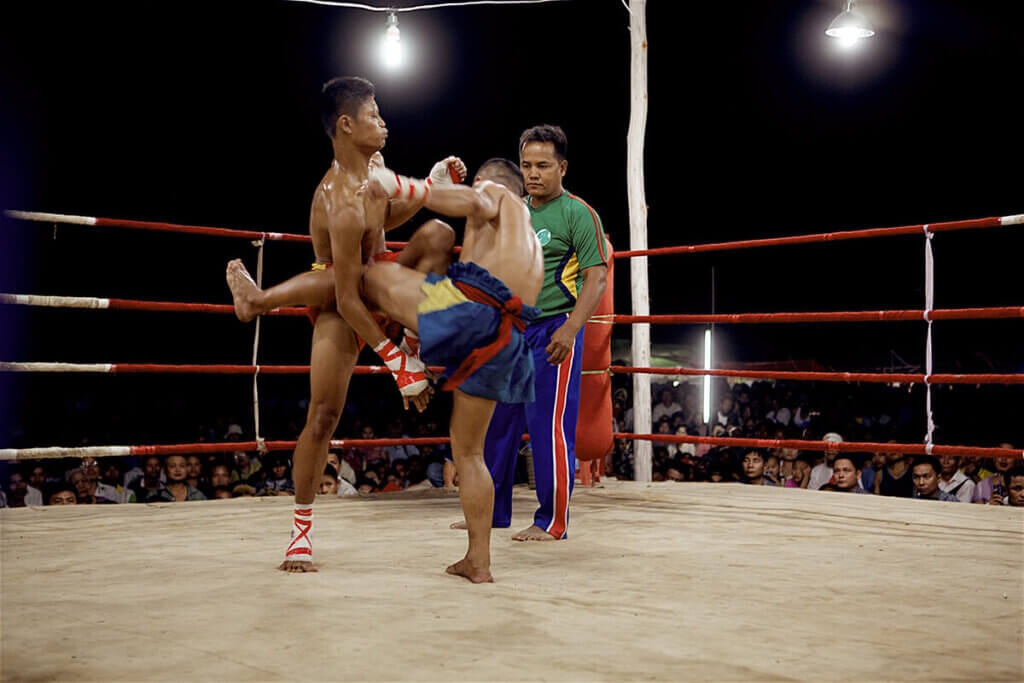
by Vincent Giordano
Burmese Lethwei, also known as Burmese boxing in the West and Myanmar traditional boxing in Myanmar, is a bare-knuckle fighting sport well known for its traditional fighting technique and the durability of its competitors. Fighters wrap their hands with only a thin gauze wrap and tape. There are no gloves used, and head-butts and throws are allowed. No judges oversee the matches to determine a points victor. The only way to win is to stop your opponent by a knockout, technical knockout or by a doctor stoppage. If there is no definitive winner then the match is declared a draw.
In ancient times, Lethwei was referred to as the sport of warriors. In the smallest towns and largest cities, men worked hard to develop their boxing prowess. Tournaments were held on every festival holiday, and fighters were handsomely rewarded for their style and skill. Until the time of the last Burmese king in the late 1800s, the best warriors were designated as “Royal Boxers”, and their names were recorded on the royal treasury rolls.
For decades, due to the country’s controlling military junta, Lethwei remained confined to Myanmar and had little outside exposure. However, the sport is being revitalized due to the opening of the country to the outside world in 2011.
Lethwei began its slow climb back to notoriety after it attracted the attention of local businesspeople who saw the sport as a commodity that could be built up within Myanmar and possibly exported to the international community.
One benefit of this surging interest has been the staging of many large-scale tournaments in major cities such as Yangon and Mandalay, and the rise of modern training camps, several of which have been sponsored by interested businesspeople. In contrast, many camps beyond the major cities are rudimentary and operate under deep financial hardship.
“It’s been a continual struggle to keep our camp going,” says Saya Ko Aung Pawe Mg, the head of the Yangon-based Aphyu Yaung Thwat Tit Lethwei Club. “All we have is this street in our community to train in. People know us and allow us to train here. We have no ring, very little equipment, but we train hard every day, twice a day. We take every fight we can get to help support the fighters and our small camp.” Aphyu Yaung is a testament to the struggle Lethwei fighters face when they try to survive without any sponsorship or outside support.
One of the more successful camps in Yangon is Nagaman, a spacious facility with a full-sized elevated ring, the product of generous funding from a local businessman. “The financial sponsorship keeps the fighters focused on training and competing,” explained Saya Kyaw Soe, Nagaman’s head trainer. “Life can be tough when a fighter has to worry about working and his family. Here he focuses on training to win and nothing else.”
Many Lethwei camps are in a similar position to Aphyu Yaung in that they leverage minimal resources to turn out tough fighters. Another camp that is navigating a different path for its fighters is the Thut Ti Lethwei Club run by Saya Win Zin Oo. Saya Oo has long been a fixture on the Lethwei circuit. He is known as the ambassador of Lethwei for having assisted the many foreigners who have attempted to compete or train in Lethwei over the last two decades.
Thut Ti doesn’t have sponsors or donors, but instead derives its income in part from teaching Lethwei to those who want to learn the sport but not fight in the ring. “Our fighters help teach the classes and make money that way. When they fight, the camp gets only 10 percent, and the fighter gets 90. The idea is for the camp and everyone in the camp to be self-sufficient,” says Saya Oo. The fighters at Thut Ti train in the afternoon, and anyone who is preparing for their fights will train then. The open training sessions take place in the morning and evening, so there’s no conflict between fighters and people attending classes.
Lethwei continues to evolve and build within Myanmar, but the sport still has a long way to go. International exposure has been limited, with Singapore taking the lead by hosting several events. In rural areas, small camps produce regional fighters who will compete during holidays like Thingyan and in brutal flag fights, which have an unlimited final round. These fighters will fight their way up through the ranks to compete in the bigger tournaments for larger paydays and a chance at being a champion. The sport gives hope to the rural poor, who see Lethwei as a way out of their dire situation.
Lethwei has survived through decades of turmoil and hardship. It has yet to attract international mainstream appeal, but it remains a symbol of hope for many Burmese youth who fight each day for a better tomorrow.
The original article was published online by the now defunct Fight Sport Asia website on August 13, 2015. It is duplicated here without any modifications or updates.
Story and Photos ©2015 Vincent Giordano. All rights reserved.

Leave a Reply
You must be logged in to post a comment.